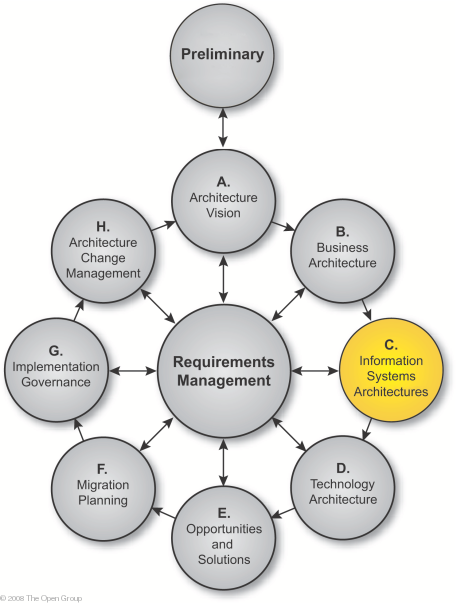-
9. Phase C: Information Systems Architectures
This chapter describes the Information Systems Architectures for an architecture project, including the development of Data and Application Architectures.

Figure 9-1: Phase C: Information Systems Architectures 9.1 Objectives
The objective of Phase C is to develop Target Architectures covering either or both (depending on project scope) of the data and application systems domains.
Information Systems Architecture focuses on identifying and defining the applications and data considerations that support an enterprise's Business Architecture; for example, by defining views that relate to information, knowledge, application services, etc.
9.2 Approach
9.2.1 Development
Phase C involves some combination of Data and Application Architecture, in either order. Advocates exist for both sequences. For example, Steven Spewak's Enterprise Architecture Planning (EAP) recommends a data-driven approach.
On the other hand, major applications systems - such as those for Enterprise Resource Planning (ERP), Customer Relationship Management (CRM), etc. - often provide a combination of technology infrastructure and business application logic, and some organizations take an application-driven approach, whereby they recognize certain key applications as forming the core underpinning of the mission-critical business processes, and take the implementation and integration of those core applications as the primary focus of architecture effort (the integration issues often constituting a major challenge).
9.2.2 Implementation
Implementation of these architectures may not necessarily follow the same order. For example, one common implementation approach is top-down design and bottom-up implementation:
- Design:
- Business Architecture design
- Data (or Application) Architecture design
- Application (or Data) Architecture design
- Technology Architecture design
- Implementation:
- Technology Architecture implementation
- Application (or Data) Architecture implementation
- Data (or Application) Architecture implementation
- Business Architecture implementation
An alternative approach is a data-driven sequence, whereby application systems that create data are implemented first, then applications that process the data, and finally applications that archive data.
9.3 Inputs
This section defines the inputs to Phase C.
9.3.1 Reference Materials External to the Enterprise
- Architecture reference materials (see Part IV, 36.2.5 Architecture Repository)
9.3.2 Non-Architectural Inputs
- Request for Architecture Work (see Part IV, 36.2.17 Request for Architecture Work)
- Capability Assessment (see Part IV, 36.2.10 Capability Assessment)
- Communications Plan (see Part IV, 36.2.12 Communications Plan)
9.3.3 Architectural Inputs
- Organizational Model for Enterprise Architecture (see Part IV, 36.2.16 Organizational Model for Enterprise Architecture), including:
- Scope of organizations impacted
- Maturity assessment, gaps, and resolution approach
- Roles and responsibilities for architecture team(s)
- Constraints on architecture work
- Budget requirements
- Governance and support strategy
- Tailored Architecture Framework (see Part IV, 36.2.21 Tailored
Architecture Framework), including:
- Tailored architecture method
- Tailored architecture content (deliverables and artifacts)
- Configured and deployed tools
- Application principles (see Part III, 23.6.3 Application Principles), if existing
- Data principles (see Part III, 23.6.2 Data Principles), if existing
- Statement of Architecture Work (see Part IV, 36.2.20 Statement of Architecture Work)
- Architecture Vision (see Part IV, 36.2.8 Architecture Vision)
- Architecture Repository (see Part IV, 36.2.5 Architecture
Repository), including:
- Re-usable building blocks
- Organization-specific reference models
- Organization standards
- Draft Architecture Definition Document (see Part IV, 36.2.3
Architecture Definition Document), including:
- Baseline Business Architecture, Version 1.0 (detailed), if appropriate
- Target Business Architecture, Version 1.0 (detailed)
- Baseline Data Architecture, Version 0.1
- Target Data Architecture, Version 0.1
- Baseline Application Architecture, Version 0.1
- Target Application Architecture, Version 0.1
- Draft Architecture Requirements Specification (see Part IV, 36.2.6
Architecture Requirements Specification), including:
- Gap analysis results (from Business Architecture)
- Relevant technical requirements that will apply to Phase C
- Business Architecture components of an Architecture Roadmap (see Part IV, 36.2.7 Architecture Roadmap)
9.4 Steps
Detailed steps for Phase C are given separately for each architecture domain:
- 10. Phase C: Information Systems Architectures - Data Architecture
- 11. Phase C: Information Systems Architectures - Application Architecture
9.5 Outputs
The main outputs of Phase C are:
- Refined and updated versions of the Architecture Vision phase deliverables, where applicable, including:
- Statement of Architecture Work (see Part IV, 36.2.20 Statement of Architecture Work), updated if necessary
- Draft Architecture Definition Document (see Part IV, 36.2.3
Architecture Definition Document), including:
- Baseline Data Architecture, Version 1.0
- Target Data Architecture, Version 1.0
- Baseline Application Architecture, Version 1.0
- Target Application Architecture, Version 1.0
- Data Architecture views corresponding to the selected viewpoints addressing key stakeholder concerns
- Application Architecture views corresponding to the selected viewpoints addressing key stakeholder concerns
- Draft Architecture Requirements Specification (see Part IV, 36.2.6
Architecture Requirements Specification), including such Information Systems Architecture requirements as:
- Gap analysis results
- Relevant technical requirements that will apply to this evolution of the architecture development cycle
- Constraints on the Technology Architecture about to be designed
- Updated business requirements, if appropriate
- Information systems components of an Architecture Roadmap (see Part IV, 36.2.7 Architecture Roadmap)
- Design: